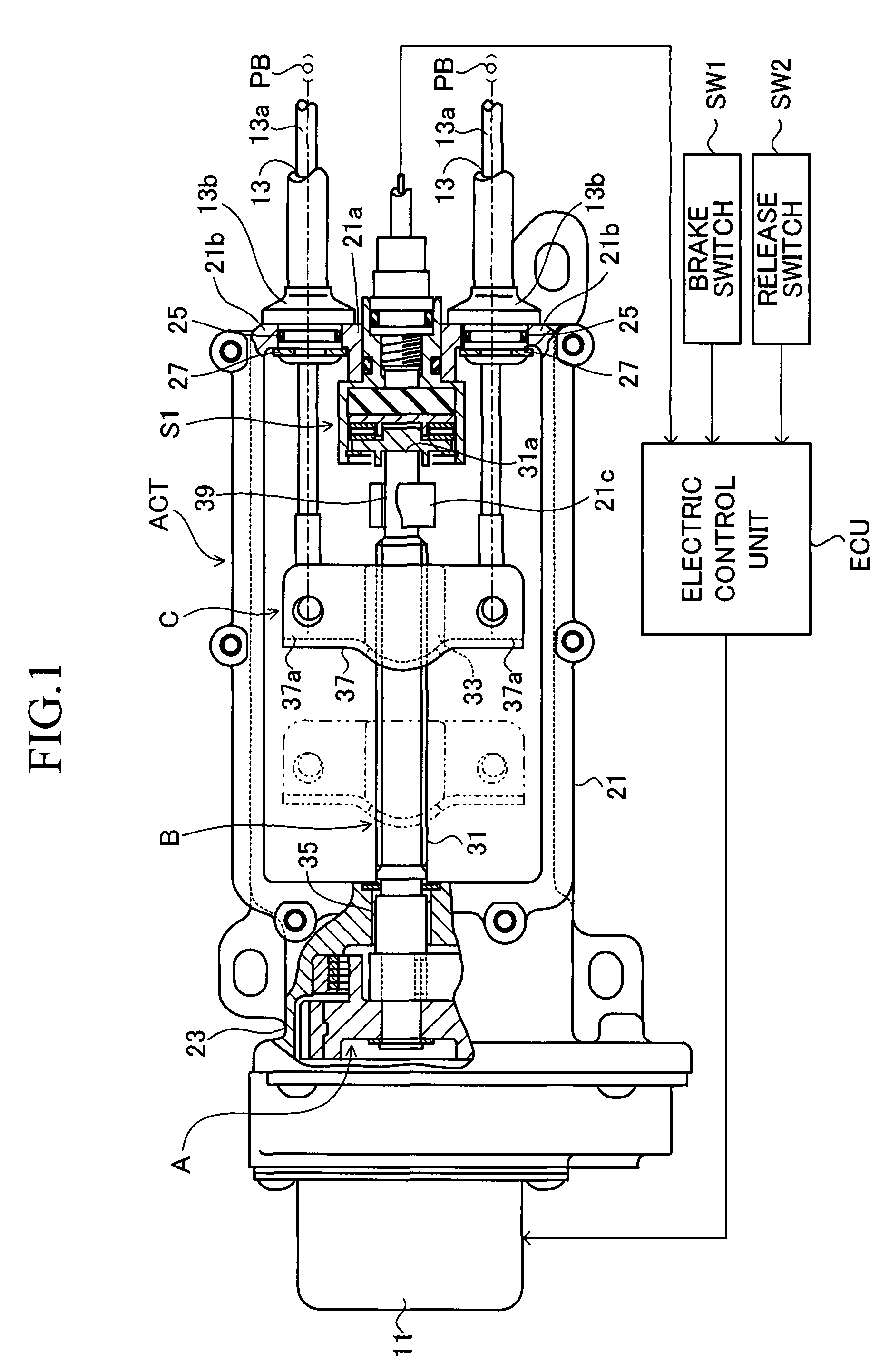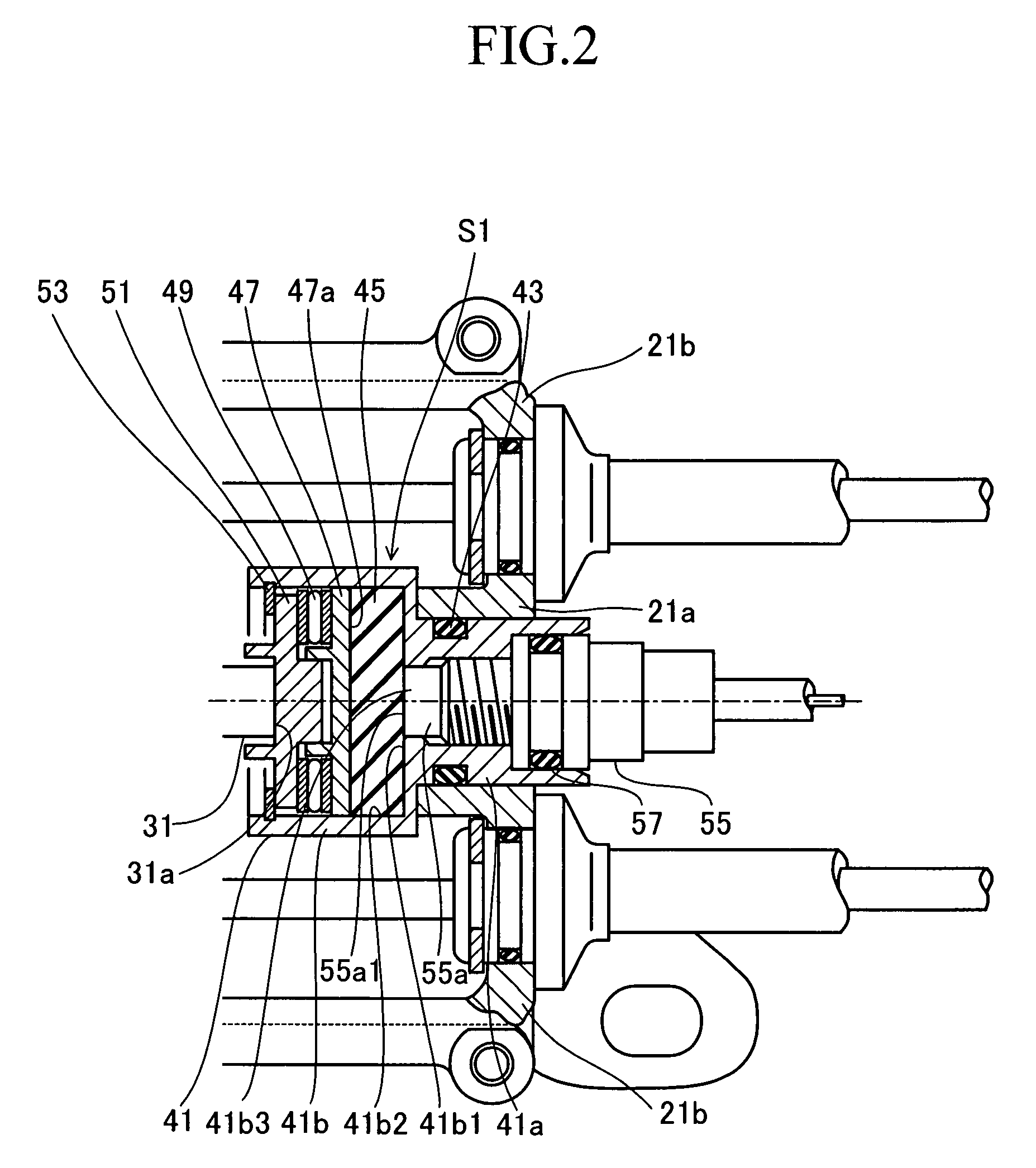Motor-driven parking brake apparatus
a technology of parking brakes and brakes, which is applied in the direction of braking systems, apparatus for force/torque/work measurement, instruments, etc., can solve the problem of increasing the size of the load sensor, and achieve the effect of suppressing the occurrence of situations and increasing the accuracy of release determination
- Summary
- Abstract
- Description
- Claims
- Application Information
AI Technical Summary
Benefits of technology
Problems solved by technology
Method used
Image
Examples
first embodiment
[0027]FIG. 1 shows a motor-driven parking brake apparatus for an automobile according to a first embodiment of the present invention. This motor-driven parking brake apparatus includes an actuator section ACT, a pair of parking brakes PB driven by the actuator section ACT, and an electric control unit ECU which controls the actuator section ACT. The actuator section ACT includes a speed reduction mechanism A for transmitting rotational drive torque of an electric motor 11, while reducing the rotational speed; a conversion mechanism B for converting rotational motion, transmitted by the speed reduction mechanism A, into translational motion; an equalizer mechanism C which distributes force produced by the translational motion to two output portions; a pair of cables 13 whose first ends are connected to the corresponding output portions of the equalizer mechanism C and whose second ends are connected to the corresponding parking brakes PB; and a pressure sensor S1 (load sensor) which ...
second embodiment
[0049]Next, a motor-driven parking brake apparatus according to a second embodiment of the present invention will be described. This second embodiment differs from the first embodiment only in the point that in place of the pressure sensor S1, a displacement sensor S2 is used as a load sensor for detecting the axial load of the screw shaft 31. Hereinbelow, only the point of difference will be described with reference to FIG. 4, which is an enlarged view of the displacement sensor S2. In FIG. 4, members and portions identical with or equivalent to those shown in FIG. 2 are denoted by like reference numerals, and their descriptions will not be repeated. For each of the axially movable members shown in FIG. 4, a corresponding axial position in a state shown in FIG. 4 (when the total load F is zero) is referred to as “original position.”
[0050]A spool 61 (movable member), which assumes the form of a stepped cylindrical tube and has a larger diameter portion 61a, a flange portion 61b, and...
third embodiment
[0061]Next, a motor-driven parking brake apparatus according to a third embodiment of the present invention will be described. This third embodiment differs from the second embodiment only in the point that in place of the displacement sensor S2, a displacement sensor S3 is used as a load sensor for detecting the axial load of the screw shaft 31. Hereinbelow, only the point of difference will be described with reference to FIG. 5, which is an enlarged view of the displacement sensor S3. In FIG. 5, members and portions identical with or equivalent to those shown in FIG. 4 are denoted by like reference numerals, and their descriptions will not be repeated. For each of the axially movable members shown in FIG. 5, a corresponding axial position in a state shown in FIG. 5 (when the total load F is zero) is referred to as “original position.”
[0062]In the cylindrical columnar interior space of the cylindrical cup portion 41b of the casing 41 of the displacement sensor S3, a ring-shaped was...
PUM
 Login to View More
Login to View More Abstract
Description
Claims
Application Information
 Login to View More
Login to View More - R&D
- Intellectual Property
- Life Sciences
- Materials
- Tech Scout
- Unparalleled Data Quality
- Higher Quality Content
- 60% Fewer Hallucinations
Browse by: Latest US Patents, China's latest patents, Technical Efficacy Thesaurus, Application Domain, Technology Topic, Popular Technical Reports.
© 2025 PatSnap. All rights reserved.Legal|Privacy policy|Modern Slavery Act Transparency Statement|Sitemap|About US| Contact US: help@patsnap.com



